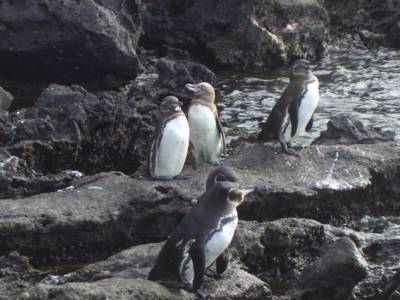
But for me, the volcanic composition of the island was just as beautiful. Since the mineral content of the lava varied significantly, the colors of the rocky terrain varied as well.

In addition, variations in how the lava flowed and cooled made for interesting textures, crests, dips, and boulders. For example, in some areas, large gas bubbles were trapped as the lava cooled. These left small hills of lava, some of which have caved in over the years. I could also see the trails of lava tubes as they extended down from the peak. Areas of ash covered patches of the island providing stark textural contrasts to the rocks and large boulders.

Although Bartolmé is not nearly as young as some of the other islands, not many plant species have colonized here. Those that have are few and far between. I don’t really understand why this is; I would think that a couple of million years would be plenty of time for more plant species to get going. Perhaps there have been more recent lava flows that covered plants as they were getting started. In any event, the deep-black rocks created a colorful contrast to the pioneer plants that do grow here. There was the great mat plant. And then there was the lava cactus, which I found especially visually pleasing.

Like most of the pioneer plants, these cactus don’t need much in the way of soil; they send down roots into the volcanic cracks and crevices to get the little water they need to survive. Their new growth is yellowish, turning green, and then brown as they decay creating a little bit of soil for the next generation of growth
We took a panga ride over to the beach, where we would snorkel later in the day. On the way over we saw some Galapagos penguins. I have had the opportunity to hang out with penguins at the New England Aquarium. Their areas are extremely cold, and I usually have to leave after a short time. So, I was surprised to find penguins in the Galapagos, where it is pretty much warm year round. As it turns out, they are endemic and are yet another example of evolutionary adaptations over the millennia.

Tom, TM, Calliope, and I all went snorkeling and pursued some of those Galapagos penguins. They are evidently shy and built to swim fast, so we didn’t swim any of them with them, but the snorkeling was glorious. This section of shoreline sported sculptural underwater rock formations as well as colorful anemone growing on them.
Tom and I both spotted a chocolate chip sea star (sorry, no underwater pictures), even though he went out way before I did and we didn’t actually snorkel together. There were so many different kinds of fish, that I couldn’t remember most of them by the time I got back to shore. TM spotted a turtle that swam up from the bottom right between the two of us. It paddled as if in slow motion, very easily and steadily. It was so close to us, I stayed on guard not to accidentally bump into it. At the time, I thought that perhaps sea turtles have poor vision. Later, our guide assured me that sea turtles see just fine underwater.
The sea lions once again made themselves available for fun and frolicking. Although, I was too cold by that time to take advantage of them; Calliope swam with them until the very last panga with the very last guide and the very last passengers started heading back to the ship.

No comments:
Post a Comment